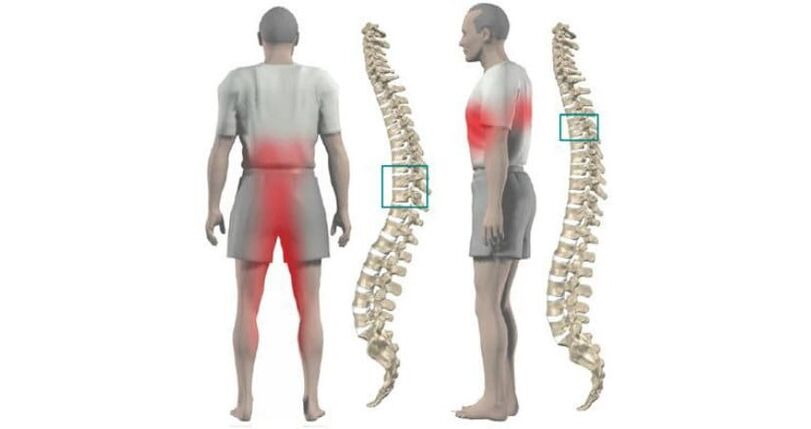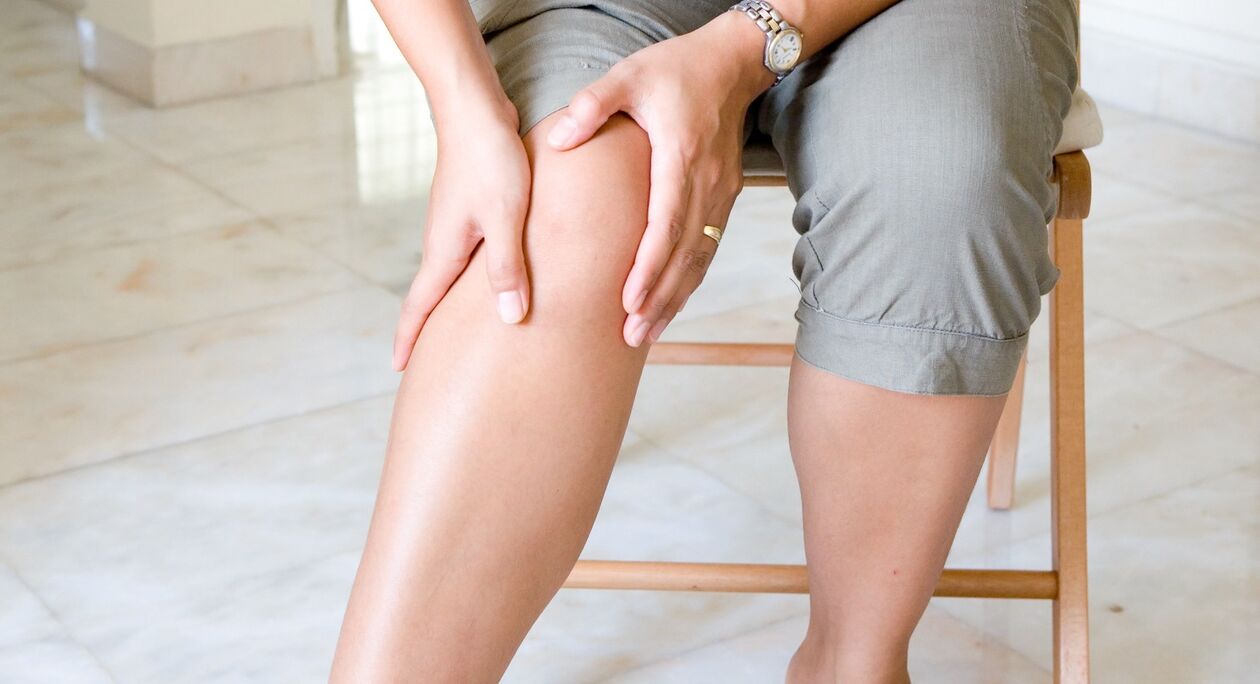The "string of pearls" of the spine requires a lot of attention, if there is no proper prevention of spinal diseases, symptoms of osteochondrosis arise. The treatment in this case is long, and it is impossible to completely restore the integrity of the spine and cartilaginous discs.

In general, osteochondrosis is considered an alteration in the bone tissue, ligament apparatus, cartilage and intervertebral discs of the spine. This process is long, the changes do not appear "suddenly", but are felt by the first characteristic signs and symptoms. Most of the time, it is mainly the pain that appears when nerve fibers, soft tissue or blood vessels are violated. The signs of osteochondrosis depend directly on the stage of the disease course and the area of the lesion, the treatment at each stage is different.
Clinical condition
Walking upright is a distinguishing feature of a person as homo sapiens and, at the same time, the upright position is the main reason for the development of osteochondrosis. No representative of the 4-legged fauna is familiar with the symptoms of osteochondrosis. When walking upright, the intervertebral cartilages undergo a colossal load, and over time they undergo changes, deformation occurs, and the spine ceases to perform its functions completely.
Four groups of characteristic changes:
neurological syndrome
With symptoms of nerve damage, there may be loss of skin sensation or decreased muscle strength. In spinal osteochondrosis, the first sign of neurological disorders can be considered the onset of pain, which is a consequence of compression or irritation of the spinal roots. The first signs are located in a limited area of the back where the pathological changes began. With progression, the pain gradually "spreads" to all parts of the body located in the innervation zone of the compressed nerve root. First, there may be pain in the arms or legs, this state of affairs often gives an erroneous idea of the diagnosis and treatment is not carried out properly.
In neurological syndrome, symptoms of impaired motor function develop less frequently than sensitive ones. If this happens, symptoms of partial or total loss of mobility in the arm or leg may be observed, for example: in sacrolumbar osteochondrosis of the spine, paresis of the right or left leg is manifested.

static syndrome
The first symptom already appears when the changes start in the vertebrae. As a result, an incorrect posture develops: lordosis, kyphosis or scoliosis. In difficult cases, there is a limitation in the mobility of the articular surfaces of the spine, the signs of which are expressed in the impossibility of fully straightening or turning the head.
vascular syndrome
Spine vascular problems develop for the following reasons:
- Sympathetic SN low tone (signs of chronic ischemia of internal organs).
- With local compression of blood vessels by altered vertebrae or their processes. The signs of osteochondrosis in this case are expressed in a violation of the blood supply to the brain when large vessels are compressed. Symptoms of oxygen deprivation include dizziness, insufficient blood supply to the inner ear, or nausea. Symptomatic treatment, as a rule, does not give serious results.
Trophic Syndrome
These symptoms of osteochondrosis are characterized by the appearance of skin ulcers, resulting from tissue malnutrition. Skin lesions appear in combination with neurological and vascular factors. The exact signs depend on which part of the back is affected.
Typical manifestations of pathology
Each part of the spine has its own typical signs of osteochondrosis, whereby a spinal neurologist diagnoses the disease in both men and women. Based on these symptoms, you can understand which parts of your back are affected and which treatment is needed first.
There are several types of osteochondrosis: thoracic, cervical, lumbar, sacral and mixed, when the location of the signs is not in one department, but is diffuse in character. The first signs of development of osteochondrosis in women and men begin to be felt with small dull pains, discomfort, crushing, often with thoracic osteochondrosis, pain that occurs in the heart region. Ideally, treatment should start at this stage so that it will be possible to avoid all back problems in the future.
In addition, the signs of osteochondrosis become clear and painful sensations begin to appear in the arms or legs. Back pain increases with any load, and gradually it becomes problematic to perform movements associated with forward flexion. The more osteochondrosis manifests itself, the more limited the mobility of the back, the narrow intervertebral discs lose flexibility, the distance between the vertebrae decreases, and their mobility is lost. The muscles start to function in "emergency mode", being constantly in tension, supporting the vertebrae to prevent them from coming together and completely destroying the intervertebral discs.
Contracted muscles cause even more discomfort to the individual, increasing tension, pain, symptoms of osteochondrosis intensify.
cervical pathology
The signs of cervical osteochondrosis often "hide" under the guise of other illnesses. The first sign of neck pathology is a headache that cannot be relieved by conventional pain relievers. It starts at the back of the head, all the way to the temples. Unpleasant sensations intensify after a long stay in one position; numbness usually appears in the arm, scapula, and shoulder. With strong compression of the nerve fibers, paresis or paralysis of the hand may occur.
When blood vessels are violated, signs of stroke appear:
- Tinnitus, dizziness - speak of poor blood flow in the cochlea and semicircular tubules.
- Decreased vision, flies in front of the eyes - indicate poor nutrition of the optical system.
- Severe lack of oxygen to the brain - can manifest itself in a sudden loss of consciousness, especially if cervical osteochondrosis is accompanied by atherosclerosis of the vessels.

Hiccups, feeling short of breath, shortness of breath, and panic attacks "speak" of phrenic nerve damage. The phrenic nerve is part of the cervical plexus and is directly related to regulating the frequency and depth of breathing.
breast pathology
The signs of thoracic osteochondrosis are quite diverse, although this part of the spine is less affected in both women and men. Painful sensations have a clear location: the upper abdomen, the area of the shoulder blades and between the ribs. But osteochondrosis is often "hidden" behind signs of intestinal or renal colic, angina pectoris, or cholecystitis.
Symptoms that indicate injury to one or another thoracic segment:
- Upper thoracic segment. Feeling of lump in the throat, violation of the act of swallowing, coughing.
- Middle thoracic segment. Symptoms that mimic gastritis and ulcers (gastralgia) and symptoms such as arrhythmia and hypertension (cardialgia).
- Lower thoracic segment. Symptoms of intestinal motility disorders and appendicitis-like signs appear.
lumbar pathology
The signs of injury in this section are extensive, but most often the first signs are felt as pain in the lower back and legs, loss of sensation, and numbness of the skin in the lower extremities.
Changes in the lumbosacral region, characteristic symptoms:
- Pain and lumbago are seen after physical exertion.
- When the motor nerve fibers are compressed, paresis and paralysis of the legs occur.
- The compression of nerves and blood vessels in men and women leads to the rupture of Organs pelvic organs.
It should always be remembered that osteochondrosis of the spine is an occult and insidious disease. You can treat the respiratory, genitourinary, or gastrointestinal tract for years, but not get positive results from the therapy. Therefore, in case of signs of illness, it makes sense to consult primarily with a neurologist rather than a cardiologist, therapist or gastroenterologist.





































